

US Marines are seen firing from behind a sand bag entrenchment which they threw up as protection on the flat island of Tarawa where the highest point of land was only 12ft. (Bettmann/Corbis)
Utilizing the islands and atolls ceded to them after World War I, Japan had constructed an outer ring of defenses, ranging from the Marianas to the Marshall Islands in the east. An attack on the island of Makin in the northern Gilbert Islands, by a Marine Raider Battalion in August 1942, alerted the Japanese to the vulnerability of the Gilberts, and the token force in the area was reinforced by a much larger contingent of troops. The island of Betio (pronounced “baysho”) on the atoll of Tarawa was selected as a main base as it afforded the best site for an airfield, and construction battalions began building the island’s defenses in September.
Lying some 2,500 miles southwest of Hawaii, Tarawa was the most southerly point in Japan’s outer defense ring and it held a pivotal position on the lifeline from Hawaii and the United States to the South Pacific, Australia, and New Zealand. It was vital that this lifeline be maintained and most Allied operations in 1942 and early 1943 were conducted to that end. The invasion of Guadalcanal in 1942 and the operations in Papua New Guinea steadily rolled back the Japanese forward positions that threatened Australia.
Vice-Admiral Raymond A. Spruance and his planning team were reluctant to take too great a risk in what was to be the Marines’ pioneering amphibious assault against the enemy. The decision was made to assault an island that could be readily taken with whatever resources were available at the time; a flawed decision as events were subsequently to prove.
The Gilberts had until recently been British territory and the Americans had access to a wide range of up-to-date information about the islands from British and Commonwealth expatriates. At a conference held in Hawaii in September 1943, Operation Galvanic was formulated and the first of the “island hopping” operations was approved.
As a branch of the Navy, the operations of the United States Marine Corps in the Pacific came under the direct control of Admiral Chester W. Nimitz, Commander-in-Chief Pacific Fleet (CINCPAC) and Pacific Ocean Area (CINCPOA). Spruance continued to act for Vice-Admiral “Bull” Halsey who was then still in hospital; for the rest of the war he would act as the CINCPAC’s chief strategist and right-hand man, planning almost every amphibious landing up to Okinawa.
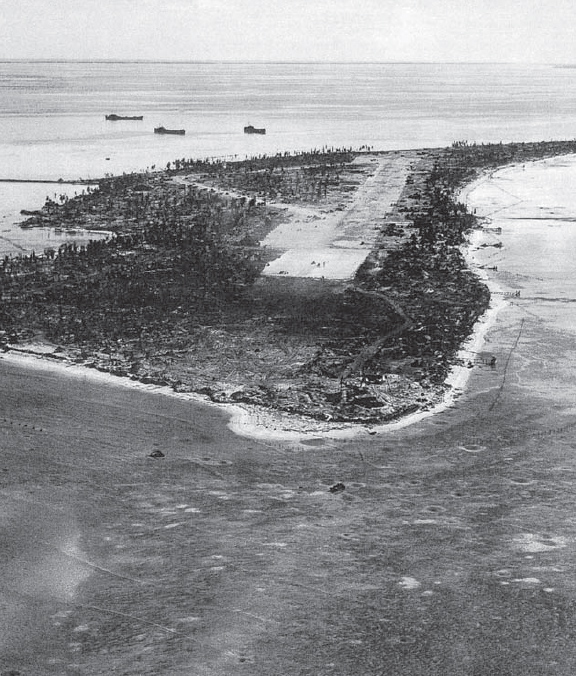
Betio Island from the west. Taken after the battle, this photograph shows the size of the island with its dominant airfield, and Green Beach in the foreground. It is difficult to comprehend that over 5,600 people died here in the space of 76 hours. (USAF)
The Marines earmarked for the operation, the V Marine Amphibious Corps (VMAC), were under the overall command of Major-General Holland M. Smith. His benign, grandfatherly appearance belied an explosive temper that prompted his Marines to adopt his initials “H. M.” to “Howlin’ Mad,” a title that stuck for his entire career. Smith was a champion of amphibious warfare, and had helped pioneer the techniques years earlier in the Caribbean. The outbreak of war found him in charge of Army and Marine amphibious training on America’s West Coast, and he immediately became the prime choice for Galvanic.
The assault on Betio was allocated to the 2nd Marine Division under its commander, Major-General Julian C. Smith. He was an unassuming and experienced officer, with 34 years’ service behind him including a spell fighting the “banana wars” – clandestine battles fought in the jungles of Haiti and Nicaragua in the 1920s and 1930s against revolutionaries.
Getting the Marines to the Gilberts, and putting them ashore was the job of the Commander of Task Force 54, Rear-Admiral Richmond Kelly Turner, a master of amphibious warfare who had previously organized the landings on Guadalcanal.
At a lower command level there were several officers whose contribution has been recognized as very significant to the success of Galvanic. Colonel David M. Shoup was 38 at the time of the battle, and had only limited combat experience. He was the divisional operations officer responsible for planning the attack down to the last detail. Although wounded coming ashore, after Shoup landed on D-Day he immediately set up a command post and directed operations throughout the most critical period of the battle, until relieved on November 21. His leadership and devotion to duty won him the Medal of Honor. Another key role was played by Major Michael Ryan, commanding officer of Company L of the 2nd Marines. When his battalion commander, Major Schoettel, failed to land on Red Beach 1, Ryan gathered together a mixture of scattered infantrymen, tank crews, amtrac drivers, engineers, and corpsmen to secure Green Beach, earning Ryan a much-deserved Navy Cross.

Colonel David M. Shoup. As divisional operations officer he planned the assault on Betio Island and was unexpectedly given the job of implementing his own plans. Shoup was awarded the Medal of Honor for his role in the battle, and in 1959 was appointed Commandant of the US Marine Corps. (USMC)
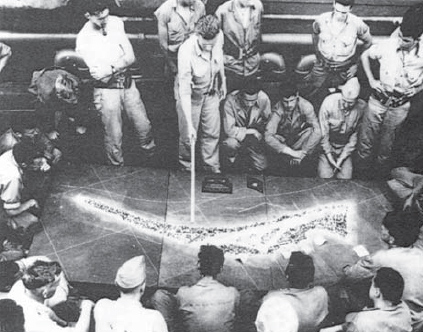
Models of Betio Island, codenamed Helen, are displayed before the landings. (NARA)
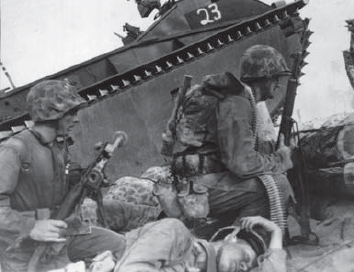
US Marines seen sheltering behind an LVT on Tarawa beach. (Tom Laemlein)

The Sherman tank played a pivotal role in the capture of Betio Island and provided invaluable assistance to the infantry in mopping up pockets of resistance. (NARA)
The Gilbert Islands came jointly under the control of the Commander-in-Chief, South East Asia, Vice-Admiral Kusaka, and the Commander-in-Chief 2nd Fleet, Vice-Admiral Kondo. Their sole contribution was to make the decision to reinforce the Gilberts, and to bolster the air detachments in the Solomons. Once Operation Galvanic was under way Tarawa was virtually abandoned.
As commander of the 111th Construction Unit, the placement of the defenses of Betio and the construction of the airfield fell to Lieutenant Murakami. More an engineer than a fighting man, he performed a brilliant job and turned the island into what was, yard for yard, probably the best defended outpost in the Pacific.
Murakami’s aim was to prevent the enemy from reaching the beaches. He knew that if the Americans could establish a landing force in substantial numbers at any point on the island it would only be a matter of time before the defenders would be overwhelmed. His obstacles included pyramid-shaped reinforced concrete tetrahedrons which were placed around half of the island on the coral reef, anti-boat barriers made of palm tree logs, and barbed wire.
Ashore were anti-tank ditches, dug a short distance back from the perimeter barricades, and extensive minefields. He turned Betio into what his compatriots called “a hornet’s nest for the Yankees.”
In September 1943, Rear-Admiral Keiji Shibasaki took over command of the island and its defenders. He boasted that, “The Americans could not take Tarawa with a million men in a hundred years.” Himself a veteran of amphibious landings along the coast of China, he fully appreciated the difficulties facing the invader and planned accordingly.
The Marines’ only practical experience of amphibious landings to date had been at New Britain, New Guinea, and Guadalcanal where the landings had been opposed only lightly, if at all. At Tarawa the plan was for the Marines to assault an island that was known to be heavily defended. The outcome would decide the whole future of the Navy’s proposed “island-hopping” strategy for the remainder of the Pacific War.
“The Americans could not take Tarawa with a million in a hundred years.”
– REAR-ADMIRAL SHIBASAKI, SEPTEMBER

Japanese tanks were inferior to the American Shermans in all respects and as a result many were used as static artillery pieces. (Tom Laemlein)
At the time of Galvanic the 2nd Division numbered around 20,000 men, composed of three infantry regiments, the 2nd, 6th, and 8th (the USMC traditionally refer to their regiments simply as “Marines”). An average regiment would comprise about 3,500 officers and men, and would have three rifle battalions consisting of three rifle companies, one weapons company, and one HQ company.
There were additional organic units within the division. A tank battalion of three companies of three tank platoons was using the Sherman M4-A2 medium tank. These were ideal for use against the Japanese in the Pacific where they completely outclassed the Japanese “Ha-Go” tanks. There was also a medical battalion and the amphibian tractor battalion who were the first to use the improved LVT-2 tractor universally known as the amtrac. The Marines at Tarawa, unlike those who fought at Guadalcanal, had modern infantry weapons including Garand M-1 semi-automatic rifles, Browning automatic rifles, and portable flame-throwers.
From the time of their embarkation in Wellington, New Zealand, on November 1, until they left the line of departure for the invasion beaches, the Marines of Holland Smith’s V Amphibious Corps (VMAC) were the responsibility of the US Navy. The invasion force – Task Force 54 (TF-54) – was subdivided into two groups: the Northern Attack Force (TF-52) under Rear-Admiral Richmond Kelly Turner, which was to secure the island of Makin to the north; and the Southern Attack Force (TF-53) under Rear-Admiral Harry Hill, which would take Tarawa Atoll.
The fire support group, under Rear-Admiral H. F. Kingman, comprised the battleships Tennessee, Maryland, and Colorado; the heavy cruisers Portland and Indianapolis; the light cruisers Mobile, Birmingham, and Santa Fe; and the destroyers Bailey, Frazer, Gansevoort, Meade, Anderson, Russell, Ringgold, Dashiell, and Schroeder. The three battleships of the group were semi-obsolete ships that had been salvaged from the mud of Pearl Harbor after the 1941 attack. However, they still packed a hefty punch with their 14in and 16in guns, and were ideally suited to provide offshore bombardments.
For air cover, aerial bombing, and strafing during the operation, three aircraft carriers, the Essex, Bunker Hill, and Independence, of Rear-Admiral Montgomery’s TF-50-3 would accompany the Southern Attack Force.
The battle for Tarawa would see the first confrontation between the US Marines and Japan’s Special Navy Landing Force (SNLF) – sometimes referred to as the “Imperial Marines.” The SNLF could trace its origins to the earliest days of the Imperial Japanese Navy (IJN) when they were developed as small infantry units attached to naval ships. Over the years, however, they evolved into much larger combat units of highly trained and specialized amphibious infantry. In 1941 they had spearheaded the invasions of Guam, Wake Island, and the Solomons.
On Betio Island, Rear-Admiral Shibasaki commanded the 3rd Special Base Defense Force (formerly the 6th Yokosuka SNLF), the Sasebo 7th SNLF, the 111th Construction Unit, and a detachment of the 4th Fleet Construction Department; in all around 5,000 men. Because of the small area of the island, a considerable amount of which was taken up by the airfield and its facilities, Shibasaki concentrated his efforts on defeating the invader at the water’s edge. Consequently the beach defenses were formidable. Pride of place went to four 8in naval guns.






Map showing Tarawa Atoll, the scene of the Marines’ “island hopping”, which started at Betio on November 20.
A major factor of the Tarawa battle was speed: Nimitz ordered Spruance to “get the hell in there, and get the hell out.” The fear of a major Japanese naval retaliation was paramount in the thinking behind this, the first of the Marines’ “island-hopping” campaigns. However, a series of US offensives in the Solomon Islands in early 1943 had caused the Japanese to divert ships and aircraft from as far away as the Marshalls, the Marianas, and the Celebes, to counter a very real threat against their stronghold of Rabaul. The IJN took a serious view of the threat, and transferred a large number of ships from Truk to bolster the Rabaul defenses. As a result the naval forces in the Marshalls were so weakened that they were incapable of repelling any major landings in the area.
The Gilbert Islands had been under British jurisdiction since 1915, and consequently the Marine planners were able to draw upon the experience of a number of British, Australian, and New Zealand expatriates nicknamed the “foreign legion.” The all-important subject of tides worried Shoup and his staff. Betio Island was surrounded by a reef which extended for some 800–1,200 yards out to sea. The first three waves of 1,500 men were due to land in amtracs (LVTs), therefore the depth of water around the island was, theoretically, irrelevant. However, the remainder would come ashore in Higgins boats – Landing Craft Vehicle Personnel (LCVPs) – shallow-draught, 36ft long boats with wide ramps, which drew only 3–4ft of water when loaded.
Opinions among the “foreign legion” were varied; some thought that there would be enough water to allow the Higgins boats to clear the reef, but Major Frank Holland, who had lived in the Gilberts for 15 years, and had studied the tides, was appalled. He knew that there would be a “dodging” tide at that time, giving no more than 3ft of water over the reefs. If his predictions were correct the second wave of Higgins boats would be grounded before reaching the beaches.
Julian Smith had intended to land with two regiments abreast and with one in reserve, but Holland Smith announced that the 6th Marines would be held as corps reserves. This, coupled with a decision by Nimitz to limit the pre-invasion bombardment of Betio to around three hours on the morning of D-Day (to achieve “strategic surprise”), meant that the Marines would be mounting a frontal attack with only a 2–1 superiority; well below the desired minimum.
Colonel Shoup and the 2nd Division planners had decided to attack from the lagoon side, which was minimally less well defended, and offered calmer waters for the amphibious assault craft. The assault plan was relatively straightforward. The transports would assemble to the west of the atoll and disembark the Marines. The landing craft would make their way to the boat rendezvous area, just outside of the gap in the western reef, from where they would move in predetermined waves to the line of departure some 7,000 yards inside the lagoon. From there the Marines were released from Navy control and the assault waves, headed by the amtracs, would make the final dash of around 6,000 yards to the beaches.
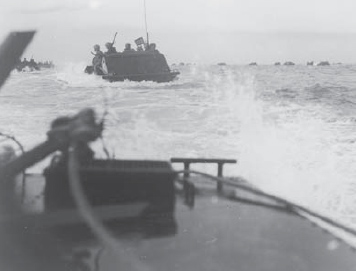
“Alligator assault,” Tarawa, 1943. Tarawa marked the first tactical employment of tracked landing vehicles as assault craft. The Alligators negotiated the barrier reef and delivered 1,500 Marine riflemen to the beach, but were too few and too shot-up to shuttle the remainder of the assault force from the reef. (USMC)

Blackened by fire and pock-marked by machine-gun fire, the Sherman medium tank “Colorado” sizzles in the lagoon. “Colorado” recovered from being set ablaze from a Japanese shell and rendered invaluable support to the infantry. Tarawa marked the Sherman’s combat debut in the Pacific, although few survived the battle. (USMC)
The three landing beaches were designated from west to east as Red 1, 2, and 3. The 3rd Battalion, 2nd Marines, under Major John Schoettel, were to land on Red 1: a deep cove, its eastern half was protected by a log barricade and covered from both sides by heavy machine guns and artillery. Red 2 stretched for about 500 yards from the eastern end of the cove to a quarter-mile long pier, and was assigned to the 2nd Battalion, 2nd Marines, under Lieutenant-Colonel Herbert Amey. There was a 3–4ft-high log wall along the entire length of this beach, and from the pier to a point level with the end of the airfield runway. Red 3 stretched for 800 yards intersected by the short Burns-Philp pier; here the 2nd Battalion, 8th Marines, under Major Henry Crowe, would land.
The western end of Betio had been designated as Green Beach and the southern shore as Black 1 and 2 but no landings were planned here on D-Day.
Shibasaki’s prime objective was to prevent the invader reaching the beaches. He knew his first defense was a natural one: the shelf-like reef surrounding the whole island, which was to prove almost catastrophic to the Marines. At the water’s edge a log barricade surrounded most of the island, and behind it, at strategic points, were coastal guns ranging in caliber from 3.1in to 8in, dual-purpose anti-aircraft guns and more than 30 other pieces ranging from 3in pack howitzers to 0.5in machine guns. In the center of the island the airfield, with its 4,000ft runway, was dominant. Anti-tank ditches were dug at both ends of the airfield and near to the 8in Vickers guns. Offshore concrete, log, and barbed wire barricades were so placed that, by avoiding them, the landing craft would enter “killing channels” covered by the main gun batteries. Shibasaki and his engineers had concentrated the defenses on the southern shore of the island from where they expected the Marines to land due to the natural geography of the island atoll.
In the pre-dawn darkness of November 20 the invasion fleet lay off the coast of Betio. The planners had called for a raid on the island by B-24 Liberator bombers of the 7th Air Force. But the raid never materialized; this was the first of a number of “foul-ups” that were to rob the Marines of an opportunity to cut back on the enemy’s firepower on the beaches.
By 0300hrs the transports were in position and the long and laborious task of disembarking the troops and filling the landing craft began. The amtracs and LCVPs went into the water, came alongside the troop transports, and the precarious business of loading the Marines got under way. Although they had practiced many times before leaving New Zealand, the maneuver was fraught with danger. Climbing down netting on the side of a tall troopship, laden with anything up to 100lb of equipment, in almost total darkness in a choppy sea was not the ideal way of leaving ship.
At around 0500hrs a Kingfisher spotter-plane was launched from Hill’s flagship, the Maryland. Its job was to observe the imminent naval bombardment and radio back corrections to range and direction. Seeing the flash from the ship’s catapult, the Japanese manning the 8in gun at Temakin Point opened fire on the Maryland. The battleships and cruisers swung around, and fired in retaliation. Marines in their landing craft watched in awe as the massive shells howled over their heads and the sky was lit up with monstrous flashes.

The Japanese caused devastating damage to the amtracs approaching Red Beach 1. Here abandoned LVTs and floating bodies at the log barricade bear witness to the effectiveness of the defenses. (NARA)

The seawall, almost the only cover on the beachhead from the accurate Japanese gunfire, gave the Marines time for a brief respite before they went “over the top” to attack the airfield. (NARA)
Aboard the old battleship Maryland, the terrific concussion from the broadsides from the 16in guns caused lights to go out and radios to malfunction. From that moment, until the end of the battle, communications between Hill and the rest of his command would be a serious problem. At 0530hrs it became evident that the troopships were out of position – a strong southerly current had carried them within range of the enemy shore batteries. The shelling was abruptly terminated as the ships scurried to their new positions, followed by flotillas of landing craft. Shibasaki was now fully aware that the Americans intended to attack from the north. He was also aware of the problems still facing the enemy: the natural protection of the coral reef and the low tide that morning. When to his relief the massive bombardment suddenly stopped, he immediately began moving men and equipment from the southern shore to the north.
Shortly after 0600hrs, the minesweepers Pursuit and Requisite began sweeping the entrance to the lagoon, and immediately came under fire from shore batteries. Once the passage was clear the destroyers Ringgold and Dashiell entered the lagoon and engaged the enemy with their 6in guns. The Pursuit meanwhile took up position at the line of departure and shone her searchlight to guide the landing craft.
It was at 0735hrs that the main bombardment by the support group got under way. In a spectacular display of pyrotechnics the battleships and cruisers raked the island. Many Marines could have been forgiven for thinking that the Betio defenses had been obliterated but the post-action review was to show that the Navy had achieved few of its aims. The ground had been well and truly churned over, but the bulk of the Japanese defenders and their weapons were still in place, awaiting the first wave of Marines.
For the landing craft the haul to the beaches seemed unending. First they had to assemble between the transports and the entrance to the lagoon; from there it was a three and a half-mile trip to the line of departure and a further three miles to the beaches. By the time they landed some of the troops would have been pitching about on the sea for nearly six hours.
At 0900hrs Hill ordered the end of the bombardment. He was worried that the smoke and dust rising from the island would affect the accuracy of his gunfire, and that the LVTs now approaching the beaches would be hit. The result was that the Japanese had a vital ten minutes in which to reorganize and bring their guns to bear on the rows of lumbering craft now approaching the end of the pier.
Braving anti-aircraft fire, Lieutenant-Commander MacPherson dived in low ahead of the flotilla and took a look at the reef. What he saw filled him with horror: instead of the 4–5 feet of water expected, the sea was so low that in places large areas of coral were drying in the sun. Major Holland’s predictions, largely ignored by the planners, would haunt many people before the end of D-Day.
As the amtracs of the 3rd Battalion, 2nd Marines entered the cove that formed Red Beach 1 they came under murderous fire from in front and from both sides. The fire from the east shore was particularly fierce. Here the enemy had in place 3in and 1.4in guns, together with numerous single and twin machine-gun emplacements. This area was destined to be the last part of Betio to be subdued by the Marines. In the face of such heavy fire many amtracs veered away to the west, coming ashore at the junction of Red Beach 1 and Green Beach, where they encountered a 5ft high seawall, and few Marines could get onto the land.
Private First Class Bob Libby from the 3.16in mortar platoon of the 3rd Battalion should have been in the third wave of Higgins boats heading for Red 1. The account of his arrival on the beach is an explicit illustration of the horror of Tarawa:
About 500 yards out our Higgins boat rammed into the reef, and everyone was ordered over the side. I landed in water well over my head, having missed the reef due to the boat being held up against it. Kicking myself from the bottom, I rose to the surface and found a footing on the reef itself. A quick look round revealed nightmarish activity; I noticed our boat drifting ashore and struck to my right, my intention being to keep the boat between me and the heavy fire coming from shore as long as I could. It was possible to keep a watch for machine gun fire skipping off the surface, a move to one side or the other allowed passage for this while still moving slowly toward the beach. Everywhere and anywhere I looked there were knocked-out amphibious tractors burning fiercely, landing craft being blown apart. The walking wounded were moving in the opposite direction making their way to drifting boats. The water around me was red or pink with a churning mass of spouting geysers; bodies were floating on the surface everywhere I looked; here a man moving along was no longer seen. The sound of screaming shells passed overhead, the unmistakable crack of rifle fire zipped around my ears, the screams of the wounded were almost lost in this cacophony of sound. If anyone can think up a picture of Hell, I don’t think that it would match up to that wade-in from the reef to the shore at Tarawa, with floating bodies and bits of bodies, the exploding shells, and burned-out craft; there was no hiding place, no protection: my only armor was the shirt on my back. It took about half an hour from leaving my boat to put foot on dry land.
In the waters off Red Beach 2 a disaster was brewing. The last of the Marine regiments to land, Lieutenant-Colonel Amey’s 2nd Battalion, 2nd Marines, were faced with rows of dug-in enemy emplacements. The objective was to land Company F on the left and Company E on the right, and for Company G to be in support; but as the first waves of amtracs came within range of the Japanese positions a hail of anti-boat artillery and small-arms fire shredded the water. The coxswains, desperate to escape the blistering barrage, put their vehicles ashore wherever they could find space. As the survivors ground ashore the troops leaped over the sides and headed for the only cover that was available: a log barricade that ran the full length of the beach.
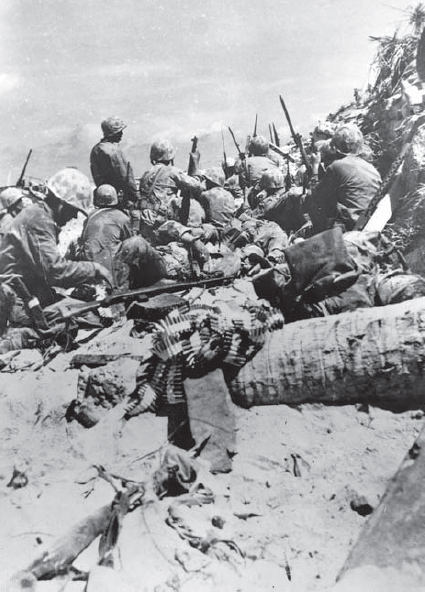
Marines huddle under cover of a sand bank, probably on Red Beach 2. The man on the left checks his .30in machine gun ammunition belts which were vulnerable to sand and grit. Losses during the landings left the assault battalions short of support weapons. (NARA)
Amey was only 200 yards from the beach when his amtrac became entangled in the barbed-wire barricade and would not budge. The colonel and his HQ went over the side and crouched alongside the craft to escape the hail of bullets lashing the water all around them. After a while there was a lull in the fire, and the group headed to the shore on hands and knees to present a smaller target. When the water became too shallow the colonel stood up and shouted: “Come on – these bastards can’t stop us!” and splashed toward the shore: he was hit in the chest and throat by a burst of machine-gun fire and died instantly. With Amey was Lieutenant-Colonel Walter Jordan from the 4th Division, who had come along as an observer. As he was the senior officer present he found himself acting commander of 2nd Battalion, 2nd Marines.
On the left-hand side of the beach Company F lost almost half of its strength as the troops attempted to get to the beach and over the log barrier at the water’s edge. Those who made it formed themselves into small units a few yards inland, armed only with light machine guns and other small arms. Most radios were saturated with seawater and were unusable, and runners soon fell prey to enemy snipers.
Company E had landed at the junction of Red Beaches 1 and 2 after their amtrac had veered away in the face of heavy mortar and rifle fire. Despite a storm directed at them they succeeded in silencing one Japanese strongpoint, but as the platoon leader fell dead they took cover in a large shell hole. Company G landed somewhere between the other two, taking heavy losses before they reached the barrier. The beach was already crowded with casualties as men attempted to locate the source of the enemy fire.
The destroyers Ringgold and Dashiell, already stationed in the lagoon off Red Beach 3, were an enormous asset to the men of the 2nd Battalion, 8th Marines. Maintaining a constant barrage along the shore they kept the defenders buttoned up long enough for “Jim” Crowe’s team to come ashore with minimal losses, and only 25 casualties in the first wave of LVTs. Crowe, the only one of the three battalion commanders to get ashore on D-Day, had to wade in when his Higgins boat ground to a halt on the reef. Even so he arrived only four minutes behind the last wave of amtracs.
The only part of the beachhead where significant gains could be made appeared to be to the east. Here Crowe’s executive officer was able to push beyond the short pier, but was soon forced back. Crowe responded by sending Company G across their flank, reinforcing it against the counterattack that he was sure would come at any moment. Like most other regimental commanders that day, he found his radio to be inoperable and sent runners toward the pier in an attempt to make contact with the Marines on Red Beach 2 at his right.
While the three assault regiments were attempting to consolidate their beachheads, Colonel Shoup was desperate to get ashore. From the mixed reports that he had received it was obvious that things were not going to plan.
His initial attempts to land had come under heavy fire, but he and his HQ finally got ashore around 1030hrs. Sprinting across the beach he received shrapnel wounds in his leg when a mortar shell exploded nearby, but he waived medical help and set up his headquarters at a bunker just inland on Red 2. Shoup’s attempts to assess the situation were frustrated by the failure of the man-pack radios, and few dispatched runners returned. Gradually however, information did begin to filter through. Shoup became aware that some troops had managed to get ashore on Red 1, and that the battalion commander, Major Shoettel, was still out in the lagoon. But he did not know that Major Ryan had landed and was rallying the stragglers at the western end of the beach. Lieutenant-Colonel Jordan had succeeded in making contact, and was told to retain command of 2nd Battalion, 2nd Marines, most of whom were huddled behind the seawall. On Red 3 he learned that some forward positions were near to the airfield taxiway, and that further east a few Marines were nearly 200 yards inland.
Shoup then gave the 1st Battalion, 2nd Marines, under Major Wood Kyle, instructions to land on Red 2 and to attempt to work westward to Red 1. However, there was another delay as Kyle searched desperately for enough amtracs to house his Marines. When the battalion finally started for Red 2 they met such a heavy and accurate barrage that many landing craft veered away to the west, ending up at the extremity of Red 1 where they were recruited by Major Ryan.
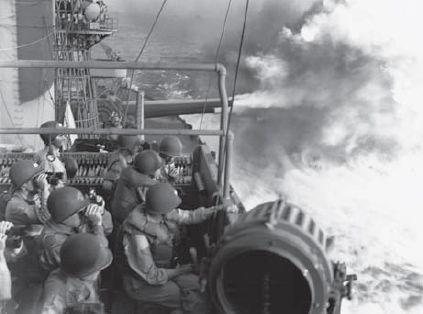
Admiral Harry Hill and staff view the attack on Tarawa Island from the bridge of USS Maryland. (Bettmann/Corbis)
At around 1130hrs Shoup ordered Major Ruud’s 3rd Battalion, 8th Marines, to land on Red 3 in support of “Jim” Crowe. There were no amtracs available at the line of departure, and Ruud and his men were left to come ashore the hard way, by Higgins boat. The Japanese gunners had now worked out the range to perfection, and the first salvos arrived just as the boats reached the reef. As the ramps came down the Marines – most of them laden with heavy equipment – leaped into the water amid a furious barrage from the artillery at the eastern end of Betio. From the shore, Crowe’s men could only watch in horror as the figures struggled forward amid exploding landing craft and spouts of artillery fire. Seeing his men facing annihilation, Major Ruud took the courageous decision to order the fourth wave back.
Julian Smith was now left with only one reserve unit, Major Lawrence Hays’ 1st Battalion, 8th Marines, and they were ordered to the line of departure in readiness. At 1330hrs Julian Smith radioed Holland Smith asking V Corps of the 6th Marines to be returned to his command. Permission was granted at 1430hrs, and he now felt confident enough to ask Shoup where he wanted the 1st Battalion to land. His message never got through, so he instructed Hays to land at the extreme eastern end of Betio and work his way northwest to link up with Shoup on Red 2. Yet again the communications foul-up persisted, and this message went missing, with the result that the batallion spent the remainder of D-Day and the following night embarked in their landing craft awaiting instructions.
Admiral Spruance aboard the Indianapolis was short of information, and could see that the operation was faltering. His staff were of the opinion that he should step in and take control, but he declined; he had selected his team and they must be allowed to conduct the battle as they saw fit.
Major Ryan found himself in charge of a bewildering mixture of men on Red 1. He had the remains of three rifle companies, one machine gun platoon, plus the remnants of Major Kyle’s 1st Battalion, 2nd Marines. Over the course of the morning he had also acquired various amtrac drivers, heavy weapons men, engineers, signalers, and corpsmen. On the eastern side of the cove the formidable cluster of Japanese defenses that had caused such havoc that morning were still intact, and Ryan realized that his best chances lay in attacking south along Green Beach. He got a message to Shoup at 1415hrs informing him of his situation, and proceeded to carve out a beachhead by overrunning several enemy pill-boxes. However, he had nothing but infantry weapons available to him, and he decided that his best option was to consolidate his position for the night.
By late afternoon of D-Day the Marines had a toehold on parts of Red Beaches 2 and 3. The battleships and cruisers continued to pound the eastern end of the island to prevent reinforcements from moving westward, and the fighters and dive-bombers from the carrier support group strafed and bombed anything that moved outside the Marines’ perimeter. Sherman M4-A2 medium tanks had been specially prepared for the landings: 6–8ft long extensions were attached to the exhausts and air intakes, to be discarded when they got ashore, and all openings below the anticipated water line were sealed with a tarlike compound. Special reconnaissance platoons had been formed to guide the tank drivers through the reef. Many would be killed attempting to plot a safe route. Remarkably, despite the fact that the floats did not work properly and the ropes became soggy with salt water, of the eight tanks only one flooded out with the remainder making it ashore on Red Beach 2. On Red Beach 1, six Shermans were landed but due to flooding and getting bogged down in shell-holes, only one, “China Gal” eventually succeeded in joining Major Ryan’s force, albeit with her main 3in gun inoperable.
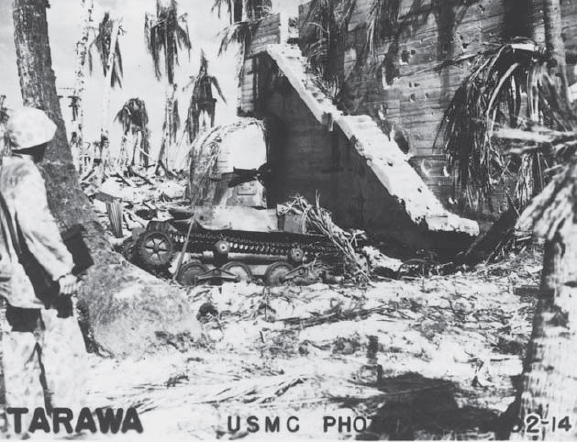
Admiral Shibasaki’s concrete bunker. It was here, on D-Day, that the Admiral and his entire HQ staff were killed by naval gunfire. This photo, taken after the battle, shows an abandoned Type 95 tank and indicates the terrific pounding that the structure suffered during the course of the battle. (USMC)
The Japanese force put up a fiercely determined defense. Their well-coordinated and accurate fire, particularly from Red Beaches 1 and 2, had caused grievous casualties to the initial row of amtracs, and the Marines, who had been compelled to wade ashore from their LCVP Higgins boats when they ground to a halt on the reef, had been decimated. Shibasaki’s four months of intensive training was paying off, although he would no doubt have regretted that he had concentrated on the southern and western defenses, anticipating that these were the most likely site for the American landings. His ambition to encircle the islands with mines, tetrahedrons, and barricades had also been thwarted by lack of time. The 3,000 mines that remained in storage were a reminder that the reefs could have been an even more formidable barrier to the invaders.
It was sometime on the afternoon of D-Day that an incident was to occur that would irrevocably alter the course of the battle in favor of the Americans. A sharp-eyed Marine somewhere on the island spotted a group of Japanese officers standing in the open and called in naval gunfire from the Ringgold and Dashiell who obliged with a salvo of 5in rounds fuzed as air bursts. The group turned out to be Admiral Shibasaki and his staff. In a gesture of benevolence, they had decided to give up their concrete blockhouse HQ for use as a hospital, and to move to a secondary command post a few hundred yards away. The resultant explosion killed Shibasaki and his entire staff.
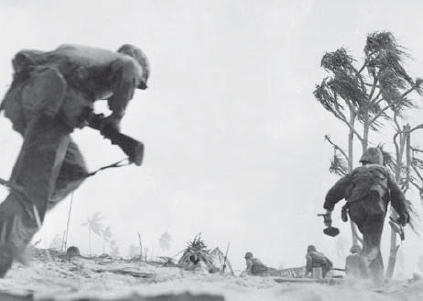
US Marines charge across open ground from the beach at Tarawa to the airport, which was the principal prize for which the bloody fight was waged. One man carries a spade to dig himself in. The Americans suffered the greatest losses of their history in this battle, but they virtually wiped out the entire Japanese garrison. (NARA)
The importance of Shibasaki’s death cannot be overestimated; had he lived he would doubtless have launched a massive counterattack on the night of D-Day against the precariously positioned Marines. There were scarcely 3,000 ashore, clinging to isolated pockets no more than a few yards inland, with little artillery support and few tanks. The Japanese were known to excel in night-time fighting, while the Marines favored defensive positions at night. What would have happened had this attack occurred is open to speculation: at best the Marines would have been subjected to a massive assault along the length of their front, with the inevitable huge casualties; at worst it could have been a monumental disaster.
The American foothold on Betio was tenuous. On the right of Red Beach 1, Major Ryan and his assorted band held a strip of the island about 250 yards wide and 300 yards long, with the sea on both sides. They were short of supplies and had no means of evacuation. On the combined Red 2 and 3 beachheads the troops were in sporadic contact with each other but there was a 600-yard gap between them and Ryan. Their line ended 300 yards from the main pier, and to the east, near the Burns-Philp wharf, a few Marines had forced their way inland to within yards of the main runway of the airfield.
The Americans were unaware of the death of Shibasaki: for decades it was assumed that he died sometime near the end of the battle. The absence of the anticipated attack was a puzzle to the staff of V Corps but deprived of their leader and senior staff the Japanese defenders lacked direction. There was some sporadic fire from the Japanese lines during the early hours, and aircraft from the Marshall Islands made an unsuccessful attempt to bomb shipping to the west of the island, but on the whole the night was fairly uneventful. With daylight came the heat and an awful smell. The scores of bodies littering the beaches and shoreline were starting to decompose where they lay; the area was still far too dangerous for the burial parties to move in, and the stench would become one of the battle’s enduring memories for the Marines as the death toll reached the thousands over the next two days.
Colonel Rixey had brought some of his artillery ashore the previous night and now it was brought into action. Siting two of his howitzers at the eastern end of Red 2 he began pounding the strongpoints at the end of the cove, enabling Major Hays’ 1st Battalion, who had already endured 24 hours in their Higgins boats without food, drink, or toilet facilities, to get ashore with slightly fewer casualties although the enemy firepower had already exacted a heavy toll prior to disembarking. At 0800hrs Hays reported to Shoup with what remained of his battalion; casualties were around 50 percent, and a great deal of equipment had been lost in the water.
As the day wore on and the tide rose, a flow of heavier equipment such as anti-tank guns, jeeps, bulldozers, and half-tracks would get ashore, but for the moment Shoup would have to make do with what he had. The principal objective for D+1 was to reach the far side of Betio, cutting the Japanese garrison in two, and to link up with Major Ryan. His surviving Marines were sent to bolster the troops on the right flank of Red 2, but even with the help of a tank to beef-up the attack, little headway was made and a grim stalemate set in.
The Japanese had used the first night to consolidate their inland defenses. The Marines who had succeeded in crossing the western taxiway of the airfield on D-Day were now trapped in a “triangle” formed by the taxiways and the main runway. The Japanese had set machine guns to cover this area; anyone attempting to cross them faced almost certain death. The Marines in the “triangle” – mainly companies A and B of Wood Kyle’s 1st Battalion, 2nd Marines – were virtually cut off from Red Beach 2. Shoup was determined to get his men across Betio, and after a concerted bombardment by carrier planes, these Marines raced across the 125-yard strip between the “triangle” and the sea, occupied a 200-yard long trench, and dug in. Later in the afternoon, Shoup sent Colonel Jordan and his 2nd Battalion, 2nd Marines, command over to the south side where Jordan assumed command. It had been hoped that this combined group would have been able to strike past and link up with Crowe, who was pressing inland from Red 3, but Jordan radioed back that he had fewer than 200 men, including 30 wounded, and that ammunition, grenades, food, and water were in very short supply. Given the circumstances, Shoup told him to consolidate his position and he would endeavor to send supplies across by amtrac.
Meanwhile, over on Green Beach, the most significant gains of D+1 were being made by Major Ryan and his assortment of Marines. Bolstered by the arrival of “China Gal” and “Cecilia,” another Sherman that had bogged down on D-Day but had now been recovered, Ryan was preparing to advance along the length of Green Beach to Temakin Point, the southwest extremity of Betio, under the cover of a naval bombardment.
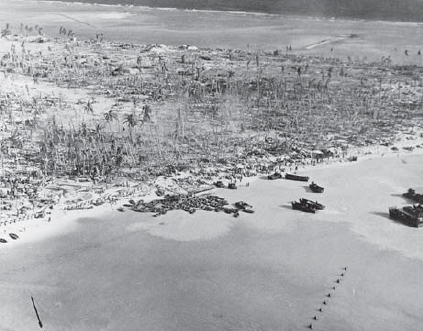
Green Beach after the landing of Major Jones’ 1st Battalion, 6th Marines, on D+1. The collection of rubber boats lie abandoned on the shore, and a few amtracs are at the water’s edge. Nearby troops assemble on the beaches. (US Navy)
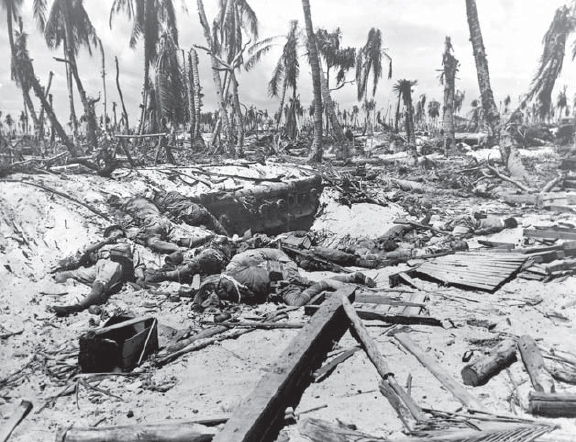
Even after D-Day, bodies remained unburied on the beaches and around pillboxes and log emplacements all over the island. It was scenes such as this, authorized for publication by President Roosevelt, that brought the horror of total war home to the American public. (NARA)
When the barrage lifted, the Marines swept forward with “Cecilia” clearing the way for the infantry, and by 1100hrs the advance party were standing alongside the 8in Vickers guns at Temakin Point. In one short and brilliantly coordinated attack Ryan had cleared Green Beach, leaving it open for the 6th Marines to make their much delayed landing. It is little wonder that Julian Smith would declare it “the most cheering news of D+1.”
At 1600hrs on D+1 Ryan and his group held Green Beach to a depth of 100–150 yards; on Red 2 the elements of 1st Battalion, 8th Marines, held the beach as far as the Japanese strongpoint at the edge of the cove; and 3rd Battalion, 8th Marines, were deployed near the Burns-Philp wharf on Red 3. Inland, 2nd Battalion, 8th Marines, had pushed forward to the edge of the airfield’s main runway, and on the south coast parts of 1st and 2nd Battalions, 2nd Marines, had a 200-yard enclave, with the enemy to their east and west. The way was now open for unopposed landings on Green Beach by 1st Battalion, 6th Marines, including some tanks. The end of D+1 saw the Marines in a much more favorable position. The failure of the enemy to counterattack on day one had given the Americans the advantage, and from there onward the issue was not in doubt. Supplies were streaming in and at 2030hrs Colonel Merritt Edson, the divisional chief-of-staff, arrived to take over command from the almost exhausted Shoup. Although Edson was officially to take over on Betio, Colonel Shoup remained ashore until the end of the battle.
From somewhere on the island a last message was flashed to Tokyo: “Our weapons have been destroyed. From now on everyone is attempting a final charge; may Japan exist for ten thousand years.”
For the third day of the battle Edson and Shoup decided on a three-front attack. Jones’ 1st Battalion, 6th Marines, were to pass through Ryan’s men and attack eastward, between the southern limit of the airfield and the sea, to link up with elements of 1st and 2nd Battalions, 2nd Marines, on the southern shore. At the same time Major Hays’ 1st Battalion, 8th Marines, were to strike west from their positions on Red 2 in an effort to reduce the stubborn pocket of gun emplacements at the junction of Red 1 and 2. The third phase was to be an eastward thrust against the enemy inland from the Burn-Philp wharf by Colonel Elmer Hall’s 2nd and 3rd Battalions, 8th Marines. It was a bold plan, especially considering that only Jones’ men were fresh; the others had been fighting ceaselessly for two days and nights with limited supplies of water, and little food. Meanwhile, Lieutenant-Colonel Kenneth McLeod and the Marines of the 3rd Battalion, 6th Marines, who had been kept in readiness at the point of departure since 1600hrs the previous day by a series of contradictory instructions, finally came ashore on Green Beach at 0800hrs, much to their relief.
Just after 0800hrs, Jones and his troops came up against surprisingly light resistance and covered 1,000 yards in less than three hours. Jones pressed on eastward, and cleared a cluster of pillboxes and bunkers. Despite the assistance of Stuart light tanks and half-tracks, by the end of the day the “Pocket,” as it became known, had not been cleared as Edson and Shoup had hoped. In fact this would remain the last position on Betio to fall to the Americans. Major Crowe’s composite unit from the 2nd and 3rd Battalions, 8th Marines, was to advance eastward, pushing beyond the Burn-Philp wharf and toward the eastern end of the main runway. They had to deal with a steel pillbox and a machine gun emplacement.
Crowe’s men then surged forward to the end of the runway, where they joined the left flank of Jones’ column. Apart from the Pocket, and a few isolated groups of enemy troops, the Marines (to all intents and purposes) held the western two-thirds of Betio. General Julian Smith had come ashore during the morning on Green Beach, and after a brief inspection transferred to the command post of Red 2 to join Edson and Shoup.
At around 1930hrs that night a small raiding party probed the defenses of the 1st Battalion, 6th Marines. At 0300hrs a second, and much larger, assault was mounted. Screaming “Marines you die!” and “Japanese drink Marine blood!” several hundred charged across the battalion front. This was the famous “banzai” charge that was soon to become familiar to Marines throughout the Pacific theater. Although it was successfully repelled, dawn revealed the extent of the carnage. Japanese dead numbered 325 for 173 Marine casualties including 45 dead. The enemy’s great banzai had failed – for the Japanese left on Betio there was little hope.
As November 23 dawned the final major actions of the battle took place. Destroyers and carrier planes had battered the area from 0700hrs to 0730hrs, prior to the Marines moving out. Supported by Sherman and Stuart tanks, McLeod’s men made good progress despite facing some suicidal resistance, accounting for some 475 of the enemy for the loss of only nine killed and 25 wounded. At 1300hrs a sweaty Marine stepped onto the sand spit at the far tip of Betio and swilled the dust from his face; the whole eastern half of the island was in American hands.
“The Marines fought almost solely on esprit decorps, I was certain. It was inconceivable to most Marines that they should let another Marine down, or that they could be responsible for dimming the bright reputation of their Corps. The Marines simply assumed that they were the world's best fighting men.”
— ROBERT SHERROD, 1943, REGARDING THE BATTLE OF TARAWA

The only sizeable body of the enemy still remaining were the defenders of the Pocket; the determined gun crews holed up in their formidable emplacements at the boundary of Red Beaches 1 and 2. Fire from 75mm artillery pieces, pounding the complex from close range, and the determined assaults by the infantry with flamethrowers and demolition charges, finally wore the defenders down. A small number surrendered, more committed suicide among the smoking debris and at 1300hrs Shoup was able to notify Julian Smith that the Pocket had finally fallen.
Mopping-up operations continued for days as the Marines checked all of the burned and shattered pillboxes and bunkers and at noon on November 24, Julian Smith and Holland Smith, who had arrived from Makin, witnessed a simple flag-raising ceremony as the Stars and Stripes and the Union Jack, to signify that Tarawa was a British possession, were raised on two battered palm trees.
All that remained was to mop up the remainder of Tarawa Atoll in a series of smaller, although still taxing operations. As recalled by Private First Class Herbert Deighton, “We chased the Japs all the way up the Atoll until we were on the last but one island: Buariki.” But by November 27 the battle for Tarawa was finally over.
With the battle over the 2nd and 8th Marines shipped out for Hawaii almost immediately; the relatively less-mauled 6th Marines stayed on to garrison the islands until they were turned over to the US Navy on December 4. At CINCPAC headquarters on Hawaii the “inquest” got under way at once – the next amphibious assault was planned for the Marshall Islands in early February 1944 and the lessons learned at Tarawa had to be discussed and implemented straight away. These included the condemnation of the use of warships as communications centers, the ineffectiveness of the naval barrage at the start of the operation, and the lack of effective waterproof covering for the man-pack radio.
Four Medals of Honor were awarded for the action on Betio, three of them posthumously. Other outstanding achievements were recognized, notably the capture of Green Beach on D+1 by Major Ryan and his gathering of the survivors of the landings on Red Beach 1. In retrospect, the capture of Green Beach was the factor that turned the tide of the battle irrevocably in the Marines’ favor, and gained Ryan a much deserved Navy Cross.
Despite the many errors and omissions, the battle was won in 76 hours of some of the most savage fighting of the Pacific War and it uplifted the spirit of the America people after years of depression. One newspaper heading read: “Last week some 2,000–3,000 United States Marines, many of them now dead or wounded, gave the nation a name to stand beside those of Concord Bridge, the Bon Homme Richard, the Alamo and Belleau Wood – that name is Tarawa.”